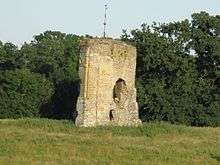Knepp Castle
The medieval Knepp Castle is to the west of the village of West Grinstead, West Sussex, England near the River Adur and the A24 (grid reference TQ163209). The name is thought to come from the Old English word "cnæp", referring to the mound on which it stands.[1]

History
The castle was originally a motte and bailey fortress, built in the 12th century by William de Braose. It was rebuilt as a stone castle with a two-storey keep in 1214 by King John. In addition to John the castle had a succession of royal visitors, including Henry III in 1218, Edward II in 1324 and Richard II in 1384. Subsequently, it fell into decline and deteriorated. The bulk of it had been destroyed by the 1720s. In the early 19th century the remnants were reinforced and fenced in by Sir Charles Burrell to protect them from further deterioration.
The castle stands on an oval mound, modelled from a natural feature, surrounded by a ditch and ramparts. The ditch, fed from a nearby pond, formed a moat which still contained water at the beginning of the eighteenth century.[1]
The surviving remains of the castle consist of a single wall 11 metres high, 9.5 metres long, and 2.5 metres thick, with a doorway and another opening above it. This wall apparently formed the north end of the west wall of a tower or keep.[1]
The name Knepp Castle is also applied to the castellated Gothic Revival mansion built nearby in the early nineteenth century by Sir Charles Merrik Burrell, to the designs of John Nash.[2]
Rewilding
Since 2001 the Knepp estate has been part of a pioneering rewilding project comprising 1,400 hectares or 3,500 acres of former arable and dairy farmland. Significantly it is the first lowland rewilding project of significant scale in England. The project uses herds of free-roaming animals including Old English longhorn cattle, Exmoor ponies, Tamworth pigs, red deer and fallow deer to drive habitat generation and focuses on restoring dynamic natural processes. The project has seen a spontaneous revival of many rare species.[3][4] It is now a breeding hotspot for purple emperor butterflies, turtle doves and nightingales.[5]
A reintroduction programme of white storks to England is in its early stages on the estate, with juvenile birds being kept in a six and a half acre pen until maturity, when they will be released.[6] Sussex was chosen for its strong historical associations with the stork. The programme aims to establish a breeding population in Britain for the first time since 1416.[7]
References
- A P Baggs; C R J Currie; C R Elrington; S M Keeling; A M Rowland (1986). T P Hudson (ed.). "Shipley: Knepp Castle". A History of the County of Sussex: Volume 6 Part 2: Bramber Rape (North-Western Part) including Horsham. Institute of Historical Research. Retrieved 28 July 2011.
- Historic England. "Details from listed building database (1354214)". National Heritage List for England. Retrieved 28 July 2011.
- "Knepp Wildland". Rewilding Europe. Retrieved 3 January 2017.
- "Welcome to the Knepp Estate". Knepp Estate. Retrieved 3 January 2017.
- "Knepp Estate". Rewilding Britain. Retrieved 3 January 2017.
- "White Storks". Knepp Estate. Retrieved 8 June 2018.
- "White storks to breed in Britain for the first time in 600 years". The Telegraph. Retrieved 8 June 2018.
- Knepp Castle Estate
- Fry, Plantagenet Somerset, The David & Charles Book of Castles, David & Charles, 1980, p. 250. ISBN 0-7153-7976-3